As American military newspapers of the First and Second World Wars were epitomized by the Stars and Stripes – which continues in publication today – so, naturally, have other nations provided news for their own servicemen. One such example from the Second World War was England’s Parade magazine, which served the British military in North Africa, Middle East, and the Mediterranean area as a whole.
First released in mid-August of 1940, Parade (edited by A.W. Parsons and Captain D.H. Flockhart) was published by the “Inter-Service Publications Directorate for the Joint Publications Board”. The magazine was printed in Cairo by the firm of Al Hilal, which was – according to the masthead – the magazine’s “Sole Distributor for Egypt, Sudan, Syria, Palestine and Cyprus”. As indicated by its intended distribution, Parade’s news coverage focused upon British military activity in the Mediterranean Theater, but in time, the magazine expanded its scope to cover news from other theaters of British military action. A central aspect of the magazine was the abundance of its photographic essays about the many national, ethnic, and religious groups of the Middle East, as well as military, cultural, and social news from the British Isles. And (!), the back page of many issues featured a full-page pin-up of a prominent (or not so prominent?!) British film actress.
Though Parade’s military news coverage naturally centered upon the activities of Britain’s military, given the vast scope of the multi-national Allied war effort in North Africa and the Middle East, it was natural that the magazine would also cover military activities and servicemen of other Allied nations.
One such example – the curiously titled photo essay “Pancakes for Breakfast”, about an American P-40 fighter squadron in North Africa – appeared in the magazine’s issue of July 3, 1943.
The anonymous author initially focused upon rations provided to American troops in the context of the American fighter squadron, and then discussed the pilots’ general living conditions, specifically mentioning the reticence of the squadron’s (anonymous) leading (7 victory) ace about discussing his aerial experiences. Based on a review of 65th Fighter Squadron aerial victories, this un-named captain was probably Roy E. Whittaker (0-431582), who attained two victories on Oct. 26, 1942, one victory on Oct.. 27, and four victories on April 18, 1943.
Though the pictures in the article (unfortunately!) have no captions, one photograph provides “the” central clue about the squadron’s identity: An image of the squadron bar shows a placard decorated with swastikas (designating aerial victories), pilots’ surnames, and primarily, a very distinctive painting of cartoon gamecock: The insignia of the 65th Fighter Squadron (Flying Cocks) of the 57th Fighter Group.
Though the roving reporter didn’t specify the date when he visited the Gamecocks, two clues in the photographs reveal the time frame of his visit.
One picture shows a discarded newspaper from Buffalo, New York (amidst a bunch of what are probably British 50 Pound Mark I aircraft bombs) with the fragmentary headline “Nazis in Tunis…” Given that Axis resistance ceased in Tunis occurred by May 13, 1943, this argues for a time-frame of late April to Early May of that year.
Another picture includes a view of the April 23, 1943 issue of Stars and Stripes, with the headline “Nazi Air Convoy Smashed”. This refers to what is commonly known as the “Palm Sunday Massacre” of April 18, 1943, in which the three squadrons of the 57th Fighter Group are credited with 49 aerial victories.
Much more information about that aerial battle is available at the 57th Fighter Group, while the first page of that very issue of the Stars and Stripes (from the 57th Fighter Group website) is shown below:
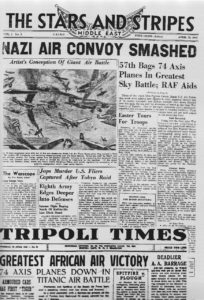 At the time, based on the Movement map of the 57th, the fighter group was based at Hani – or, “Sidi El Hani” – Tunisia, which is location number 15 on the map below (also from the 57th FG):
At the time, based on the Movement map of the 57th, the fighter group was based at Hani – or, “Sidi El Hani” – Tunisia, which is location number 15 on the map below (also from the 57th FG):
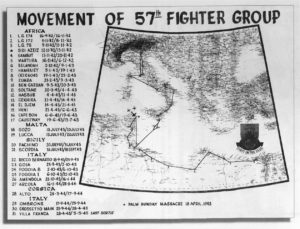 And so, here are the article and photos…
And so, here are the article and photos…
PANCAKES FOR BREAKFAST
How do the U.S. forces differ from the British in the way they spend spare time, the things they eat? A “Parade” reporter visited a U.S. Air Force unit, describes differences he noticed
It was our first visit to the American Air Force, to any Yanks in the field anywhere. There were similarities and there were differences comparing them with the R.A.F. The similarity seemed to spring from complete identity of job; they had the same modesty and sort of involuntary exclusiveness that the airman acquires, his operational element being other. The many differences were superficial. The food, for instance. For breakfast tomato juice, oatmeal (not the same as porridge), or pancakes with syrup, dehydrated eggs, peanut butter and coffee. Lunch menu was ‘Spam’ (meatcake) mealies, a sort of potato, the inevitable peanut butter and cocoa. For dinner hamburgers, vegetables and biscuits (our scones). There is the officers’ mess, where you eat, and the club where you sit and read Life, the American Parade, Stars and Stripes, innumerable shiny covered issues of Pocket Editions Incorporated; where you write letters and play poker, but very rarely drink anything, except, perhaps, iced water (many of these messes have refrigerators). Yanks are addicts to candy (candies are issued in their rations).
The Mess Sergeant
There is and there is not ceremonial. Not much saluting is done, and the officers often wear their metal bars, oak-leaves and other insignia of rank hidden under the collars of their jackets. The mess sergeant is a man of more formidable prestige than with us. You arrive a minute late for a meal and he lets you have it.’ He speaks merrily with officers, a cigar sticking out of the corner of his mouth, a slice of cake in his hand. He looks like a man behind a talkie ice-cream soda bar.
Mess conversation is much the same the world over. A difference among the Americans, though, is the ardour that comes into their voices when they talk about motorcars – automobiles to them. The convertible Cadillac is a name they conjure with indeed. The post-war ambition of one and all.
American airmen do not tell the world about their exploits. The captain I spoke to who was ‘ace’ of his squadron, with seven swastikas on the side of his P.40 fighter, made me feel like an inquisitor. He was waiting to take off on his second patrol that day. He must have been one of the youngest officers in the Wing. Not at all like a pilot in an American film. No more so than American newspapermen run true to their film types. He was quiet, almost self-effacing. These Parade pictures show an average day on a forward landing ground. It’s a dull day, punctuated by 1 ½ hour spells of excitement, perhaps one, perhaps two, perhaps three. Off duty there’s not much to do except read and play cards. Chief humorous item is listening to daily word dose under the auspices of Doctor Gobbels, a sort of fireside talk to Americans in North Africa, a wheedling address. The American airmen had their best opportunity to answer when they helped make hay of those Messerschmitts over Pantelleria.
______________________________
The photos accompanying the article appear below.
These three photographs show pilots of the 65th. Unfortunately (and unsurprisingly!) no names are given.
“Four pilots live in one tent. These three were friends back in their home town before the war so a letter from home – well, most of it anyway – is read out for the other two to hear all the news as they while while off duty.”
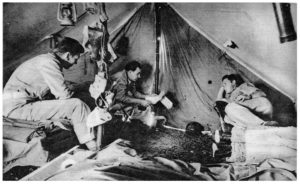 ______________________________
______________________________
These images are two different views of the interior of the squadron’s recreation tent, which also includes the squadron bar.
This “first” image shows as pilot appearing to perform some sort of mission-planning work. Next to him, the above-mentioned (April 23) issue of Stars and Stripes, with the headline clearly visible. Note the tail-fin assembly of a German bomb, to the left of the table, which now serves as a trashcan.
“Between sorties they write letters home, read large variety of magazines and newspapers – “Life,” “New Yorker,” “Reader’s Digest,” are favourites from home – with innumerable shiny issues of Pocket Editions Incorporated.”
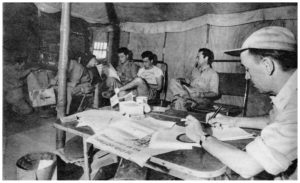 ______________________________
______________________________
For this next mage, the reporter has stepped further into the tent. The tail assembly of a even larger German aircraft bomb serves as the support for a radio (probably of British or (captured) German manufacture) which is attracting the attention of one of the pilots.
Repairing the radio is everybody’s hobby. It is an eight-valve super-heterodyne, but is usually out of order. When it does work they tune in to see what laughs Goebells can provide. Bar serves genuine cold water, a favourite drink.”
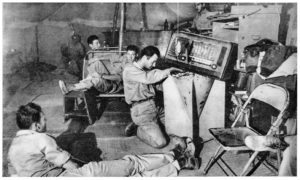 ______________________________
______________________________
“They rest, read newspaper. Crepe boots are preferred to the issue ones.”
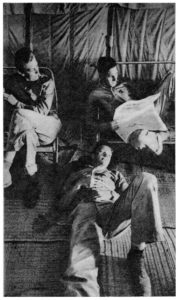 ______________________________
______________________________
Now we come to the squadron bar, which is faintly visible is the upper center of the preceding photo. The 65th Fighter Squadron Fighting Cocks insignia is clearly visible, albeit one of the pilots has carefully positioned himself to hide the squadron logo! Pilot’s names appear at the top of the board, though they’re not actually legible in this image. Unfortunately (deliberately? – accidentally?) the pilots’ names are not legible.
“Swastikas mean German aircraft down; plate was present from R.A.F.”
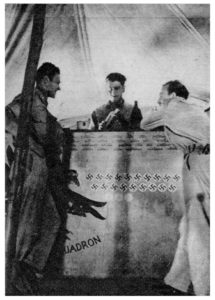 ______________________________
______________________________
A discarded Buffalo newspaper, amidst some British 50-pound Mark I aircraft bombs.
“This was the home town paper of one of the American airmen, eagerly read when it arrived, now forgotten, torn and abandoned amid the coarse scrub.”
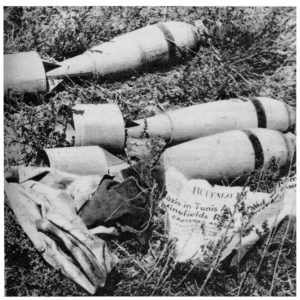 ______________________________
______________________________
But wait, there’s more!…
On December 11, 1942, American newspapers carried the following photograph, which shows an earlier version of the Fighting Gamecocks’ bar. The unattributed image (it’s not an Army Air Force photograph – I checked Fold3 and wrote to NARA!) is captioned:
“OASIS – American officers based in western Egypt pictured as they relax between raids on Axis bases. Left to right seated are: Lieutenant C.F. Costanzo, of Manchester, N.H.; Lieutenant J.L. Morris, of Silver City, N.C.; and Lieutenant A.D. Jaqua, of South Bend, In. Behind bar, left to right are: Lieutenant H.M. Cohn, of Springfield, Ma.; Lieutenant D.F. Smith, of New York; Lieutenant Walter Reed, of Reading, Pa.; Lieutenant Clair D. Knopp, Meadville, Pa.”
Here’s the image, scanned from 35mm microfilm at 300 dpi.
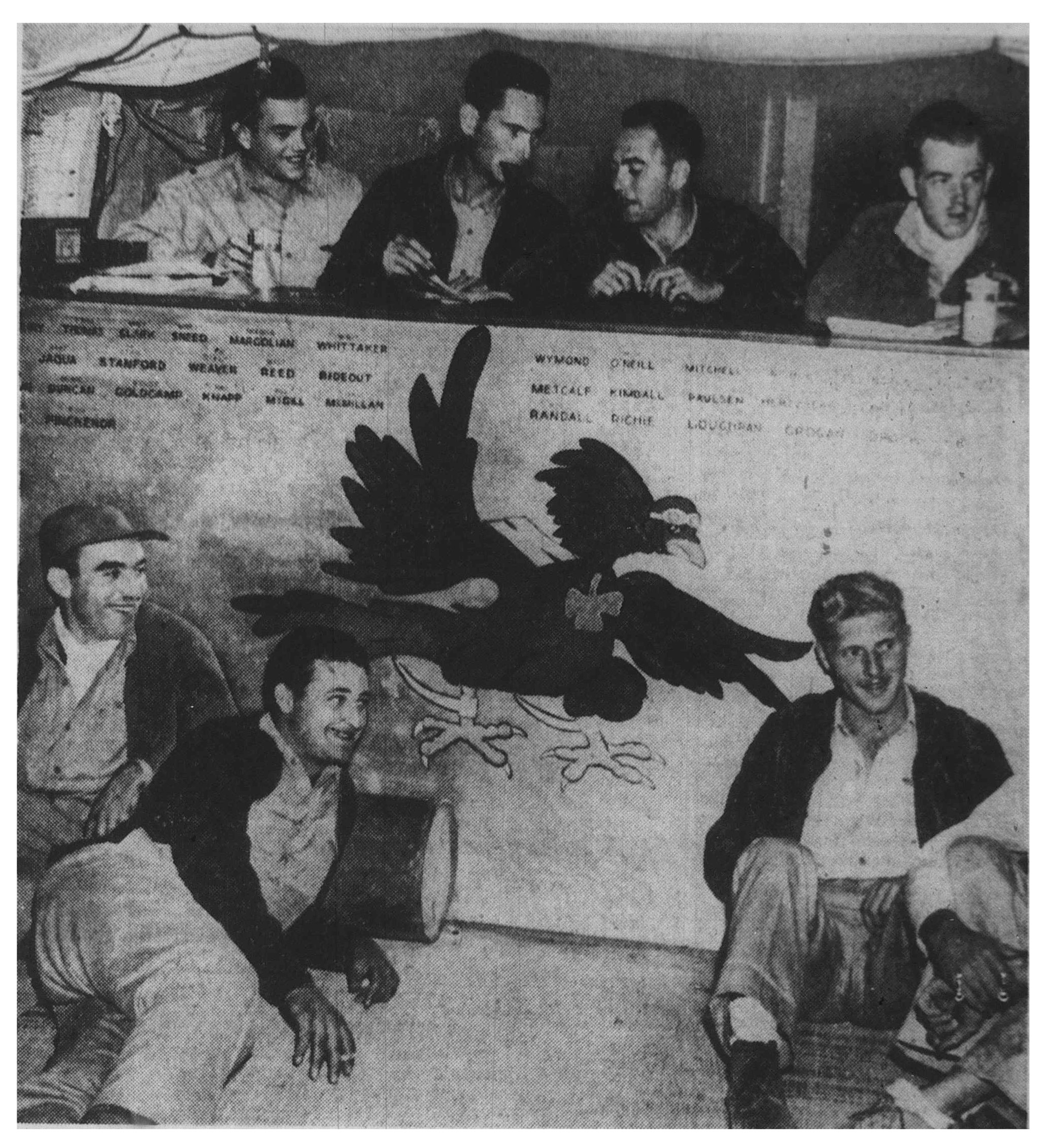 A little more information about the men in the picture. They are:
A little more information about the men in the picture. They are:
Seated
Costanzo, Charles F., 2 Lt., 0-791285; 1 Victory Jan. 11, 1943
Jaqua, Arnold D., 1 Lt., 0-440839; 2 Victories Dec. 8, 1942; KIA March 29, 1943 – No MACR
Behind Bar
Cohn, Herbert M., 2Lt., 0-791283; KIA Dec. 13, 1942, P-40 #93 – No MACR
Reed, Walter H, 1 Lt., 0-441017; 1 Victory April 18, 1943
And…”Knopp” is actually “Knapp“, Clair D., Lt
The resolution of the original print image is very good, such that many of the pilots’ surnames on the bar are legible. The names indicate:
First Row (Top)
__?__
Thomas (Gordon F. or Herbert M.) (If “Gordon F.”, then he was a Major, 0-397559; 1 Victory April 18, 1943)
Clark (Thomas W., Capt., 0-406233; 4 Victories)
Sneed (Marshall M., Capt., 0-427779; 1 Victory Jan. 20, 1943; KIA Feb. 27, 1943 – No MACR)
Margolian (Leon B., Capt., 0-420749; POW Dec. 10, 1942; P-40 #54 “Tiger Lil” – No MACR)
Whittaker (Roy E., Capt., 0-431582; 7 Victories – see above)
Wymond (Gilbert O., Jr., 1 Lt., 0-431591; 3 Victories)
O’Neill (William W., Jr.)
Mitchell (Delbert V., 1 Lt., 0421007; 1 Victory Nov. 7, 1942)
Second Row
Jaqua (Arnold D., 1 Lt., 0-440839; 2 Victories Dec. 8, 1942 – KIA March 29, 1943 – No MACR)
Stanford (Harry H. Jr., 1 Lt., 0-442298; 3 Victories April 18, 1943)
Weaver (Edwin R., 1 Lt., 0-441053; 2 Victories April 18, 1943)
Reed (Walter H., 1 Lt., 0-441017; 1 Victory April 18, 1943
Rideout (Harold C., Jr. – KIA?)
Metcalf (Robert L., 1 Lt., 0-442290; 1 Victory Oct. 26, 1942)
Kimball (Richard W., 2 Lt., 0-442139; 1 Victory Oct. 31, 1942)
Paulsen (Richard B.)
Third Row
Duncan (Harold)
Goldcamp (Robert J.)
Knapp (Clair D., Lt. – see above)
“Migell” – (McGill, William F.?)
__?__
Randall (William J., 1 Lt., 0-727543 – KIA April 18, 1943)
“Richie” (Ritchie, Dudley W.)
Loughran (Fred J.)
Grogan (Charles E., Lt. Col., 0-22355; 1 Victory in 79th FG June 10, 1943)
Fourth Row (Bottom)
Flickenor (George J., Jr.)
Given the presence of Cohn and Jaqua in the image, and, the date of the picture’s publication, the picture was probably taken in Libya during early to mid-December of 1942, at the very latest. If so, the squadron’s then location would have been in Libya, either at Martuba (from November 16 through December 6) or Belandah (from December 2, 1942, through January 9, 1943).
References
USAF Credits for the Destruction of Enemy Aircraft, World War II – USAF Historical Study No. 85, Albert F. Simpson Historical Research Center, Air University, 1978
Maurer, Maurer, Combat Squadrons of the Air Force – World War II,
British 50 Pound Mark I aircraft bombs, at MichealHiske.de
Deprecated: Function get_magic_quotes_gpc() is deprecated in /home3/emc2ftl3/public_html/wp-includes/formatting.php on line 4365
Deprecated: Function get_magic_quotes_gpc() is deprecated in /home3/emc2ftl3/public_html/wp-includes/formatting.php on line 4365
Deprecated: Function get_magic_quotes_gpc() is deprecated in /home3/emc2ftl3/public_html/wp-includes/formatting.php on line 4365